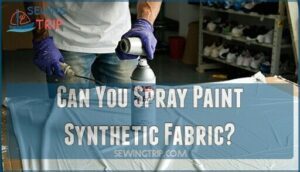This site is supported by our readers. We may earn a commission, at no cost to you, if you purchase through links.

You’ll need fabric paint or acrylic paint specifically designed for synthetics. These paints contain bonding agents that grip nylon’s smooth surface.
Before painting, clean the fabric thoroughly to remove oils and dirt. Apply thin, even coats and allow proper drying time between layers.
The key is patience—rushing leads to uneven coverage and poor adhesion. Understanding nylon’s unique properties and choosing compatible materials makes all the difference in achieving professional-looking results that actually last.
Table Of Contents
- Key Takeaways
- Can You Spray Paint Nylon Fabric?
- What Kind of Paint Can You Use on Nylon?
- Do Fabric Markers Work on Nylon?
- Can Nylon Plastic Be Painted?
- Can You Paint Nylon Webbing?
- What Paint Works Best on Nylon?
- Can You Use a Sharpie on Nylon?
- Can You Spray Paint Synthetic Fabric?
- Can You Paint a Nylon Tent?
- Frequently Asked Questions (FAQs)
- Conclusion
Key Takeaways
- You’ll need fabric-specific spray paint or acrylic paint mixed with fabric medium – regular spray paint won’t stick to nylon’s smooth, synthetic surface and will flake off quickly.
- Clean your nylon fabric thoroughly before painting to remove oils and dirt that prevent proper paint adhesion, then let it dry completely.
- Apply multiple thin, even coats rather than one heavy layer, holding the spray 6-8 inches away and allowing each coat to dry completely before adding the next.
- Test your chosen paint on a hidden area first to ensure compatibility and color accuracy – this simple step prevents costly mistakes on your main project.
Can You Spray Paint Nylon Fabric?
Yes, you can spray paint nylon fabric with proper preparation and the right materials.
Start with thorough nylon cleaning using mild detergent to remove oils and dirt that prevent paint adhesion. Choose fabric-specific spray paints or mix acrylic paint with fabric medium for flexibility.
Proper nylon preparation involves allowing the fabric to dry completely before painting nylon fabric begins. Apply spray paint nylon fabric techniques using thin, even coats rather than heavy applications.
Hold the spray bottle 6-8 inches away and use controlled bursts for best coverage. Multiple light layers create better paint adhesion than single thick coats. Allow each coat to dry completely before applying the next.
This spray painting nylon approach prevents cracking and guarantees lasting results on your nylon spray painting projects, ensuring lasting results with the right technique and flexibility.
What Kind of Paint Can You Use on Nylon?
You’ll need specific paints designed for synthetic fabrics to successfully color nylon materials.
Acrylic paint mixed with fabric medium and dedicated fabric paints offer the best adhesion and durability on nylon’s smooth, non-porous surface.
Fabric paints and acrylic-medium blends grip nylon’s slick surface better than standard paints.
Acrylic Paint
Acrylic paint offers excellent versatility for nylon fabric projects when you mix it with an acrylic medium. This combination creates superior paint adhesion while maintaining the fabric’s flexibility. You’ll achieve better color mixing results and prevent cracking that often occurs with straight acrylic paint.
Here’s what you need to know about acrylic paint application:
- Prepare the surface – Wash and dry your nylon fabric completely before starting any fabric coating process
- Mix properly – Combine acrylic paint with fabric medium in a 1:1 ratio for ideal adhesion
- Apply thin layers – Use proper brush techniques to spread paint evenly, allowing each coat to dry completely
- Heat set the finish – Iron on low heat or use a heat gun to permanently bond the paint
When you paint nylon clothes, start with dampened fabric and work in sections. This method prevents streaking and guarantees even coverage. Remember that thick applications will stiffen the material, so multiple thin coats work better than one heavy layer for professional results. For the best outcomes, consider using fabric paint techniques to achieve vibrant and long-lasting designs.
Fabric Paint
Fabric paint’s formulation makes it the superior choice for painting nylon fabric. Unlike regular acrylics, fabric paints bond permanently with synthetic fibers while maintaining flexibility after washing.
| Paint Type | Best For |
|---|---|
| Fabric Spray Paint | Large coverage areas |
| Brush-On Fabric Paint | Detailed designs |
| Acrylic + Fabric Medium | Custom color mixing |
| Permanent Fabric Paint | High-wash durability |
Choose permanent varieties designed for synthetics. Test color selection on scraps first—mistakes resist removal. Apply thin coats using proper brush techniques, allowing complete drying between layers.
For spray paint nylon fabric projects, fabric medium enhances paint adhesion substantially. The use of acid dye methods can also inform approaches to painting nylon for unique effects.
Do Fabric Markers Work on Nylon?
Drawing intricate designs on nylon fabric, fabric markers offer vibrant color application without traditional paint mess.
Nylon markers specifically designed for synthetic materials provide superior ink adhesion compared to standard markers.
Brands like Sharpie Fabric Markers and Tulip Fabric Markers deliver excellent color fastness on nylon fabric surfaces.
When painting nylon fabric alternatives, marker tips glide smoothly across the material’s surface.
Unlike spray paint nylon applications, markers allow precise control for detailed artwork.
The ink penetrates synthetic fibers effectively, though you’ll want to test marker compatibility first.
Heat-setting with an iron helps lock colors permanently.
For best results with nylon fabric paint alternatives, choose fabric dye markers over regular markers.
They’re specifically formulated for synthetic materials like nylon, ensuring your designs won’t fade or wash away easily.
Can Nylon Plastic Be Painted?
Nylon plastic’s smooth surface presents unique challenges that require strategic preparation for successful painting results.
Nylon’s slick surface fights back against paint—prep work makes all the difference.
While conventional paints struggle with nylon’s low surface energy, proper techniques can achieve durable finishes.
Here’s your step-by-step approach for painting nylon plastic:
- Surface prep: Clean thoroughly with degreaser and lightly sand with 220-320 grit sandpaper
- Nylon primer application: Apply plastic-specific primer in thin, even coats for ideal paint adhesion
- Paint selection: Choose acrylic or urethane paints formulated specifically for plastic coating
- Application technique: Spray paint nylon using multiple thin layers rather than single thick coats
- Curing process: Allow proper drying time between coats and full cure before handling
The key lies in understanding nylon’s properties.
Its moisture absorption and smooth texture make paint adhesion challenging without preparation.
Plastic coating requires specialized primers that create chemical bonds with nylon’s surface.
When spray painting nylon, patience pays off—rushing the process leads to peeling and flaking.
With proper nylon finishing techniques, you’ll achieve professional results that withstand normal use and handling.
Understanding moisture protection methods is vital for a successful paint job on nylon.
Can You Paint Nylon Webbing?
You can successfully paint nylon webbing using fabric paints specifically designed for synthetic materials. Apply 2-3 thin coats with proper primer preparation for best adhesion and durability.
Primer for Nylon Webbing
While painting nylon plastic requires specific materials, nylon webbing demands even more preparation since it’s designed for strength. Proper nylon primer creates the foundation your project needs to succeed.
Here’s your essential prep checklist:
- Clean thoroughly – Remove all dirt, oils, and moisture that’ll sabotage your fabric adhesion
- Choose fabric-specific primers – Generic primers won’t bond with synthetic prep requirements
- Apply thin, even coats – Heavy webbing coats reduce flexibility and cause cracking
- Allow complete curing – Rush this step and watch your webbing finish fail prematurely
Adhesion primer designed for synthetics etches the smooth nylon surface, giving your spray paint nylon project something to grip. Brush application works best for intricate weaving patterns, while spray primers cover larger areas quickly. Remember, you’re not just adding color – you’re engineering a bond that’ll last. Using the right nylon primer products is vital for a successful project.
Acrylic Paint for Nylon Webbing
When choosing acrylic paint for nylon webbing, you’ll want fast-drying formulas that create strong paint adhesion on synthetic materials.
Mix acrylic paint with fabric medium at a 2:1 ratio to maintain flexibility and prevent cracking during use.
| Paint Brand | Fabric Prep Method | Application Technique |
|---|---|---|
| Apple Barrel | Pre-wash webbing | Apply thin coats |
| FolkArt | Clean with alcohol | Allow complete drying |
| Liquitex | Sand lightly | Heat-set afterward |
| Golden GAC 900 | Remove nylon coating | Seal with varnish |
Proper fabric prep determines your webbing art’s longevity. Clean the surface thoroughly and remove any existing nylon coating that might interfere with adhesion.
Apply multiple thin layers rather than one thick coat – this prevents stiffness and maintains the webbing’s flexibility.
Color mixing works best when you blend paints before application.
Heat-setting with an iron locks in your design, making it washable and durable for outdoor gear projects.
Using the right acrylic fabric techniques is vital for a successful project.
What Paint Works Best on Nylon?
Four key paint types deliver superior results when you spray paint nylon fabric.
Acrylic Options mixed with fabric medium create the most reliable bond, with GAC 900 being the gold standard for Paint Adhesion.
This combination prevents cracking while maintaining flexibility.
Fabric spray paint offers convenience and proper Nylon Coatings compatibility, unlike regular aerosols that fail miserably.
Upholstery paint provides excellent coverage for larger projects, though testing remains essential.
Latex house paint surprises many with its durability on synthetic materials.
Color Durability depends heavily on surface preparation and proper application technique.
Always test your chosen paint on a hidden area first – this simple step saves countless headaches later.
Quality fabric-specific products consistently outperform generic alternatives, making your nylon paint job worth the investment in proper materials.
For the best results, understanding acrylic paint properties is essential to achieve a long-lasting finish.
Can You Use a Sharpie on Nylon?
While acrylic paint offers versatility, markers provide precision for detailed work. Sharpie Fabric Markers excel on nylon fabric with their permanent ink formula designed specifically for synthetic materials.
Here’s your marker toolkit for nylon projects:
- Test first – Try markers on hidden areas before full application
- Choose permanent ink – Sharpie Fabric Markers bond better than regular markers
- Allow drying time – Let ink cure completely to prevent smudging
- Consider alternatives – Fabric dyes and specialized nylon markers offer different effects
Sharpie Tips include working in thin layers for even coverage. The permanent ink creates lasting designs that won’t wash out easily. Ink adhesion improves when you clean the nylon surface beforehand, removing oils that might interfere with bonding.
Can You Spray Paint Synthetic Fabric?
You can spray paint synthetic fabric successfully with proper preparation and technique.
Specialty fabric spray paints bond effectively with synthetic materials while maintaining flexibility and washability.
- Choose fabric-specific spray paint – Regular spray paint creates stiffness and cracking on synthetic fabric
- Clean thoroughly before application – Remove sizing agents that prevent proper paint adhesion
- Apply thin, multiple coats – Heavy applications cause rigidity and visible surface cracking
- Test on fabric scraps first – Verify color accuracy and fabric response before full application
- Allow 24-48 hours curing time – Proper drying guarantees durability and wash resistance
Nylon coating and polyester respond well to acrylic-based fabric dye formulations designed for synthetic materials.
The key to successful spray painting is understanding fabric spray basics.
Can You Paint a Nylon Tent?
Your tent’s waterproof coating creates a challenge for paint adhesion. Most standard paints will crack and peel on nylon fabric coatings, especially when you fold and pack your gear.
Fabric-specific products like Tulip ColorShot or Simply Spray Outdoor work better than regular spray paint nylon options. These specialized formulas bond more effectively with synthetic materials. However, even quality nylon fabric spray may only last a few seasons before fading.
Before painting, clean your tent thoroughly and set it up completely. Test any product on a hidden area first—some manufacturer coatings react unpredictably. Apply multiple thin coats rather than one heavy application to maintain flexibility.
Consider that painted areas may compromise your tent’s waterproofing methods. You’ll need to reseal seams afterward. For camouflage techniques, fabric markers offer a less invasive alternative.
Remember: darker tents reduce visibility during emergencies. Your safety gear should remain recognizable to rescue teams.
Frequently Asked Questions (FAQs)
Can you spray paint nylon?
Yes, you can spray paint nylon fabric effectively.
Clean the fabric first, then apply thin coats using fabric-specific spray paint or acrylic paint mixed with fabric medium for best adhesion and durability.
How do you paint on nylon fabric?
Clean your nylon fabric thoroughly, then apply thin coats using fabric-specific spray paint or acrylic paint mixed with fabric medium.
Let each coat dry completely before adding the next layer for best adhesion.
Can You Wash painted nylon clothes?
You can wash painted nylon clothes, but use cold water and gentle detergent. Hand washing works best since machine washing might cause the paint to crack or fade over time.
Can you paint nylon T-shirts?
Like a chameleon changing colors, you can transform nylon T-shirts with fabric paint or acrylic mixed with fabric medium.
Clean first, apply thin coats, and let dry between applications for lasting results.
Can you spray paint fabric?
Spray painting fabric works well with proper preparation and the right materials.
You’ll need fabric-specific spray paint or acrylic paint mixed with fabric medium for best adhesion and durability on textile surfaces.
Can you use acrylic paint on nylon fabric?
Think of nylon fabric as a stubborn canvas – it’s smooth and non-porous like glass.
You can definitely use acrylic paint, but you’ll need to mix it with fabric medium and apply thin coats for proper adhesion.
Will spray paint stick to nylon fabric?
You’ll find spray paint can stick to nylon fabric, but it’s not always a perfect match.
Nylon’s slick surface makes adhesion tricky.
For best results, use fabric-specific spray paint and prep the fabric with thorough cleaning.
What kind of paint will stick to nylon fabric?
Fabric paints work best on nylon since they’re designed for synthetic materials. Acrylic paint mixed with fabric medium also sticks well. You’ll need multiple thin coats for durability.
How do you get spray paint off 100% nylon?
Use chemical solvents like acetone or paint thinner to break down the paint. Scrape off loosened paint gently, then soak the area in appropriate cleaner based on paint type.
Can you spray paint synthetic fabric?
Yes, you can spray paint most synthetic fabrics including polyester, nylon, and spandex.
Use fabric-specific spray paints or mix acrylic paint with fabric medium for best adhesion and flexibility on synthetic materials.
Conclusion
Painting nylon fabric is like taming a wild horse—it takes the right tools and technique to get lasting results.
You can spray paint nylon fabric to achieve professional finishes by selecting appropriate fabric paints, preparing surfaces properly, and applying thin coats patiently.
Whether you’re customizing gear, repairing outdoor equipment, or creating art projects, success depends on understanding nylon’s synthetic properties.
With proper preparation and compatible materials, you’ll transform challenging nylon surfaces into durable , vibrant finished pieces.














